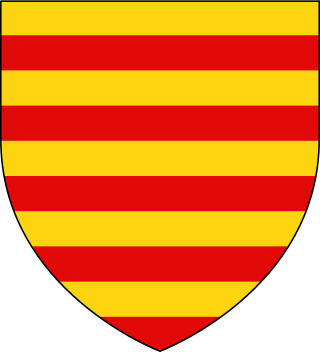Sources
Medieval Lands Projects, Graven von Aarschot
Hasselt, A. H. C. van, Les Belges aux Croisade, Jamar, 1846 (available on Google Books)
Arnout III (1080-after 1136), Count of Aarschot, son of Arnout II, Count of Aarschot, and his wife whose name remains unknown. Arnout is sometimes confused with his father, especially in regard to the blood shedding at Aachen in 1115.
Arnout supported the founding of the Averbode Abbey in 1134, part of the Archdiocese of Mechelen-Brussels, that was made possible by donations by Arnold II, Count of Looz, the Abbey of Sint-Truiden, the lords of Aarschot and Diest, and Godfrey III, Count of Louvain. In at least two documents, Arnout was not referred to as a count.
Arnout married Beatrix of Looz, daughter of Arnold I, Count of Looz and sister of his fellow benefactor of the Averbode Abbey. Arnout and Beatrix had four children:
Upon his death, Arnout was succeeded as Count of Aarschot by his son and namesake.
Medieval Lands Projects, Graven von Aarschot
Hasselt, A. H. C. van, Les Belges aux Croisade, Jamar, 1846 (available on Google Books)

The County of Loon was a county in the Holy Roman Empire, which corresponded approximately with the Belgian province of Limburg. It was named after the original seat of its count, Loon, which is today called Borgloon. During the middle ages the counts moved their court to a more central position in Kuringen, which is today a part of Hasselt, the modern capital of the region.

Averbode Abbey is a Premonstratensian abbey situated in Averbode, in the municipality Scherpenheuvel-Zichem, in the Archdiocese of Mechelen-Brussels in Belgium. It was founded about 1134, suppressed in 1797, and reestablished in 1834. Throughout the 20th century the abbey press was a leading children's publisher in Belgium. The church's building is a peculiar synthesis of Baroque and Gothic, with Renaissance ornament details, dominating the monastery complex. The whole structure was built of iron sandstone from Langdorp and white sandstone from Gobertange between 1664 and 1672, after a design by the Antwerp architect Jan Van den Eynde II.

Arnold IV of Loon (Looz) (died between November 1272 and October 1273; most likely on February 22, 1273), was Count of Loon from 1227 to 1273 and Count of Chiny (as Arnold II) from 1228 to 1268. He was the son of Gérard III, Count of Rieneck and Cunegonde von Zimmern.

Louis I was the Count of Loon, now in modern Belgium, and Burgrave of Mainz, in Germany. He inherited these offices from his father. He also established the County of Rieneck apparently based upon the Burgrave's lands.
Arnout or Arnoud is a Dutch language masculine given name equivalent to Arnold. Notable persons with that name include:
The counts of Chiny were part of the nobility of Lotharingia that ruled from the 9th to the 14th century in what is now part of Belgium.
Otto II, Count of Chiny, son of Arnold I, Count of Chiny, and Adélaïs.
John I (Jean) (d. 1278 or 1279), Count of Looz and Count of Chiny, eldest son of Arnold IV, Count of Looz and Chiny, and Jeanne, Countess of Chiny. He succeeded his father in 1272 or 1273, as the Count of Looz and Chiny. Virtually nothing is known about his reign.
Arnold V de Looz, was Count of Loon from 1279 to 1323 and Count of Chiny from 1299 to 1310. He was the son of John I, Count of Looz and Mathilde Jülich.
Godfrey de Heinsberg, Lord of Daelenbroeck, Count of Looz and Count of Chiny (1361–1362), son of John of Heinsberg, Lord of Daelenbroeck.
Arnold I, Count of Loon (Looz) from about 1079, son of Emmo, Count of Loon, and Suanhildis, daughter of Dirk III, Count of Holland, and his wife Othelandis.

Arnold II, Count of Looz, son of Arnold I, Count of Looz, and Agnes von Mainz, daughter of Gerhard I, Count of Rieneck, and Helwig von Bliescastel. He is distinguished from his father of the same name by historians who note records for counts named Arnold or Arnulf between 1179 and 1141. The first Arnold must have died between 1125 when Count Arnold appears in a record with his son also named Arnold, and 1135, when a new Count Arnold appears with his own son and successor Louis.
Count Gerard of Loon, was son and successor of Louis I, Count of Loon, and Agnes of Metz. He was count of Loon and of Rieneck. Because of a widespread misunderstanding concerning a document from 1101, some generations earlier, he is sometimes wrongly referred to as the second Gerard in this dynasty, "Gerard II".
Arnold III, Count of Looz and Count of Rieneck, son of Gérard II, Count of Looz, and Adelaide of Gelderland, daughter of Henry I, Count of Guelders, and Agnes of Arnstein, daughter of Louis III of Arnstein.
Louis III, Count of Looz, also known as Ludwig was Count of Loon and of Rieneck. He was the son of Gerard, Count of Rieneck, and Cunegonde von Zimmern, who was in turn the son of another Count Gerard who was also count of both Rieneck and Loon.
Godefroi, Count of Durbuy, son of Henry I, Count of Durbuy.
Arnout II, Count of Aarschot, son of Arnout I, Count of Aarschot.

Arnout IV (Arnold of Aerschot) (1100-after 1152), Count of Aarschot, son of Arnout III, Count of Aarschot, and Beatrix of Looz, daughter of Arnold I, Count of Looz.
Godfried III, Count of Aarschot, son of Arnout IV, Count of Aarschot.
Renaud II of Clermont was son of Hugh I, Count of Clermont-en-Beauvaisis and Marguerite de Roucy. Renaud became Count of Clermont-en-Beauvaisis upon his father's death in 1101.